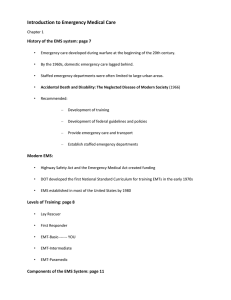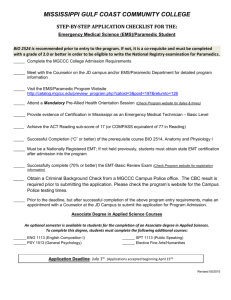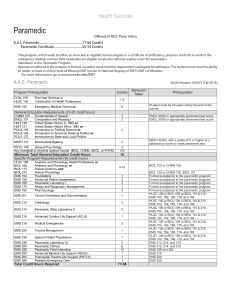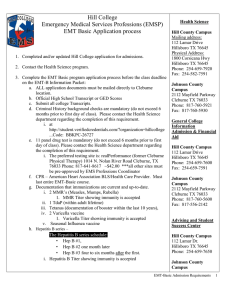Chapter 5: EMS Communications
advertisement
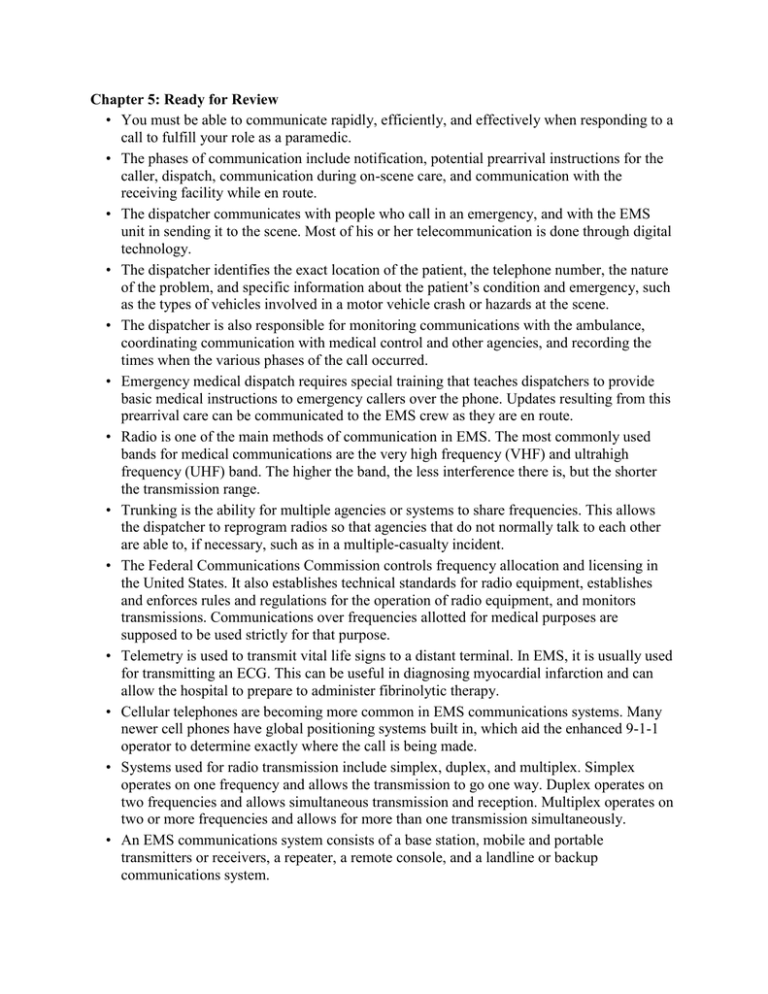
Chapter 5: Ready for Review • You must be able to communicate rapidly, efficiently, and effectively when responding to a call to fulfill your role as a paramedic. • The phases of communication include notification, potential prearrival instructions for the caller, dispatch, communication during on-scene care, and communication with the receiving facility while en route. • The dispatcher communicates with people who call in an emergency, and with the EMS unit in sending it to the scene. Most of his or her telecommunication is done through digital technology. • The dispatcher identifies the exact location of the patient, the telephone number, the nature of the problem, and specific information about the patient’s condition and emergency, such as the types of vehicles involved in a motor vehicle crash or hazards at the scene. • The dispatcher is also responsible for monitoring communications with the ambulance, coordinating communication with medical control and other agencies, and recording the times when the various phases of the call occurred. • Emergency medical dispatch requires special training that teaches dispatchers to provide basic medical instructions to emergency callers over the phone. Updates resulting from this prearrival care can be communicated to the EMS crew as they are en route. • Radio is one of the main methods of communication in EMS. The most commonly used bands for medical communications are the very high frequency (VHF) and ultrahigh frequency (UHF) band. The higher the band, the less interference there is, but the shorter the transmission range. • Trunking is the ability for multiple agencies or systems to share frequencies. This allows the dispatcher to reprogram radios so that agencies that do not normally talk to each other are able to, if necessary, such as in a multiple-casualty incident. • The Federal Communications Commission controls frequency allocation and licensing in the United States. It also establishes technical standards for radio equipment, establishes and enforces rules and regulations for the operation of radio equipment, and monitors transmissions. Communications over frequencies allotted for medical purposes are supposed to be used strictly for that purpose. • Telemetry is used to transmit vital life signs to a distant terminal. In EMS, it is usually used for transmitting an ECG. This can be useful in diagnosing myocardial infarction and can allow the hospital to prepare to administer fibrinolytic therapy. • Cellular telephones are becoming more common in EMS communications systems. Many newer cell phones have global positioning systems built in, which aid the enhanced 9-1-1 operator to determine exactly where the call is being made. • Systems used for radio transmission include simplex, duplex, and multiplex. Simplex operates on one frequency and allows the transmission to go one way. Duplex operates on two frequencies and allows simultaneous transmission and reception. Multiplex operates on two or more frequencies and allows for more than one transmission simultaneously. • An EMS communications system consists of a base station, mobile and portable transmitters or receivers, a repeater, a remote console, and a landline or backup communications system. • Keep radio communication simple, brief, and direct. One of the main goals is clarity. Use the international radiotelephony spelling alphabet to aid transmission of spellings. • Remember that your words can be heard by anyone who is listening. Keep your communications professional at all times. Do not transmit a patient’s name or personal information over the radio; this would be in violation of HIPAA. • Most ambulance systems use plain English in radio communications, but some use radio codes. If your agency uses codes, be sure to learn them. • When reporting medical information, include the patient’s age and sex, chief complaint, brief history, level of consciousness, degree of distress, vital signs, mental status, physical findings, ECG findings, treatment, and response to treatment. • Most of the people you will meet during responses will be in crisis and having the worst day of their lives. • At least half of the calls you will run as a paramedic will take you into people’s homes, day and night, and in the most private moments of their lives. Try to see every invitation into the home of someone else as a personal honor in a time and place where no one else would be welcome. • If you want people to tell you about their problems, convince them you want to hear what they have to say. Give them your undivided attention. • Active listening is repeating the key parts of a patient’s responses to questions. It helps confirm the information the patient is providing and ensures there is no misunderstanding. • A therapeutic communicator’s most essential challenge is to convey calm, unmistakable, genuine concern for someone he or she has never met. • When you first meet your patients, introduce yourself and ask them for their name. This communicates your respect for them. • Even if you are not convinced that patients are in real trouble, consider the possibility that they are terribly frightened. • External factors, such as noise, lighting, distracting equipment, and interruptions, can make communication with a patient difficult. • Patient modesty matters, no matter how acute the medical condition. If the patient is not personally sensitive to it, family members most certainly are. • When you need to know how patients feel, try asking open-ended questions—questions that do not have a yes or no answer, and which do not give them specific options from which to choose. • When you are trying to find facts (for example, a medical history), use closed-ended or direct questions. • If you sense that patients are trying to put something into words, but are having trouble, be patient. Do not say anything at all for a few seconds. Let them talk. • If you have tried clarification and you are still not sure what patients are trying to tell you, sometimes it helps to vocalize what you think they have said and invite them to correct you. • Nonverbal communication can be as powerful as words. • Direct eye contact generally communicates honesty and concern. • Posture is important. Try to position your eyes at the same level or below the level of the • • • • • • • patient’s eyes. Some people do not like to be touched at all; to others, it is a valuable assurance that someone cares about them. You should try gently touching patients on a neutral part of the body, such as a shoulder or arm, especially when you are trying to reassure them or to mitigate their fear. Hostile or angry patients may present a threat to you and others. Always approach with caution and maintain eye contact. Try not to interview them by yourself. Try not to presume that older people are any harder to communicate with than anyone else, just because they are older. Children can pose treatment and communication challenges even to the best EMS personnel. Minimize your movements, lower your voice, and touch them as gently as you can. Try keeping your eye level at or below the child’s by sitting on the floor and placing the child on the cot or on a parent’s lap. When you encounter a patient who has trouble communicating, remember that family members or primary caregivers who know these patients well can facilitate your efforts. Just as importantly, they can also help you alleviate fear. Dealing with people of cultures different from your own can be challenging. It is always considered a mark of your respect if you make an effort to learn about their language and culture. Manners, hand gestures, and body language may differ among cultures. Remember that another person’s culture may have different rules for polite behavior from your own.



